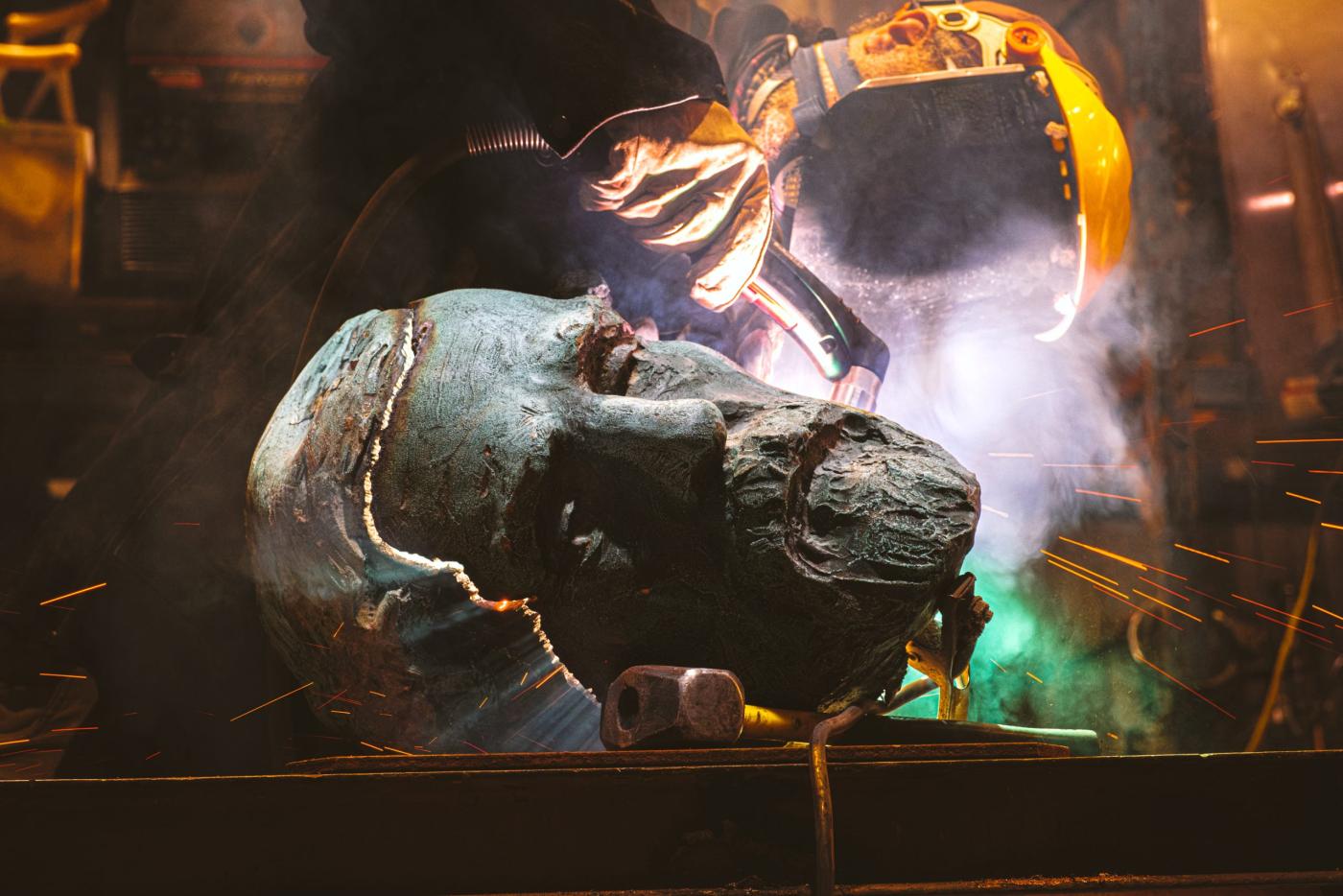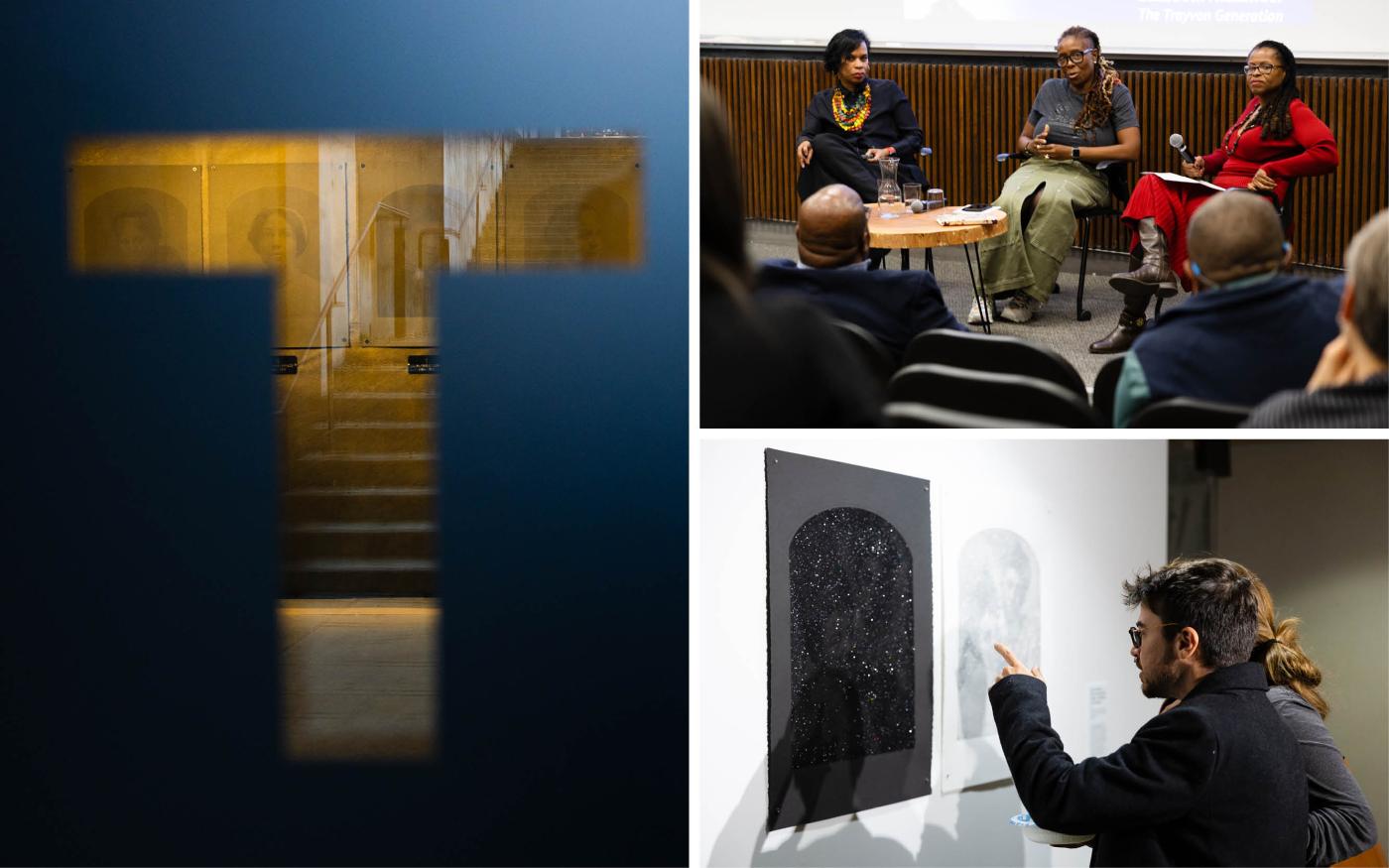
Languages of Invisibility, Devaluation, and Triumph—Exhibition + Dialogue: A Visual Recap

At the UVA School of Architecture, the Languages of Invisibility, Devaluation, and Triumph exhibition and the recent Dean’s Forum on Equity + Inclusion, featuring alum and interdisciplinary artist Veronica Jackson, foregrounded Jackson's arresting BLACKTIVISTS portrait series. This body of work is a powerful commentary on the erasure and resilience of Black women in public memory. By fusing archival research with visual storytelling, Jackson’s work monumentalizes the often-overlooked experiences of Black lives, reclaiming spaces and histories for those traditionally rendered invisible.
“Blacktivists,” a hybrid term coined by Jackson, combines the words Black and activists. “Activist” is defined as an energetic and vigorous advocate of a cause, especially a political one.
At the Dean’s Forum, Jackson introduced BLACKTIVISTS, a series depicting 13 Black women activists whose stories she discovered in the archives of the Library of Congress. Most of the women were born during the time of enslavement in the United States, and some were enslaved at birth. With varying backgrounds—including roles in architecture and education—each woman championed human rights for African Americans, women, and children at a time when it threatened their own existence. One of the women honored in her series is Anna Julia Cooper, a pioneering educator and activist who is the only woman quoted in every U.S. passport.

Jackson captures the likenesses of these impressive women through an intricate, layered process that has evolved in material and meaning over time. The series began as 12 silkscreen prints made with black ink on black embossed paper. “Barely legible, barely readable,” Jackson explained, “just like their stories, barely there unless you do the work to uncover and discover who these women are.” Later, Jackson introduced extra-fine black glitter to add reflectivity and sparkle to the portraits. In another move, she hand-printed the portraits on opalescent Bullseye glass, fired in a kiln, and mounted to onyx-stained plywood. Through a material transformation, Jackson more legibly renders the Black activists while revealing her playful experimentation with different mediums.
In addition to her BLACKTIVISTS series, Jackson presented two other projects that memorialize forgotten and devalued laborers. Her ephemeral installation of “tree bands” (titled In Memoriam: For Those Who Labored for His Happiness, 2018) involves black felt bands wrapped around trees, like armbands, along Charlottesville’s Rivanna River. Each band is embroidered with the names, professions, and birth years of a few of the many people enslaved by Thomas Jefferson at Monticello. In the project That’s Pops’s Money, Jackson pays homage to her grandmother's devalued labor that was invisible to her husband and sons throughout her life. For the piece, Jackson laboriously printed 813 timecards to represent the 67 years her grandmother’s toils went unnoticed in her marriage. Through these projects, Jackson foregrounds personal histories, cultural identities, and public memory to demonstrate how visual art can serve as a conduit for social critique.

This notion of reclaiming and recasting historical and cultural narratives through a material transformation resonates with the work of Dr. Andrea Douglas, executive director of the Jefferson School African American Heritage Center. Douglas joined Jackson at the Dean’s Forum on Equity + Inclusion, where she spoke about phase two of the Swords Into Plowshares (SIP) initiative, aptly titled “Recast + Reclaim.” SIP is a project spearheaded by the Jefferson School and supported by the City of Charlottesville to melt down the former bronze statue of Confederate General Robert E. Lee and use the material remnants to create a new work of public art.
A monument is “a statement of power and presence in public.”
—Monument Lab
In the current phase of the SIP work, Douglas asks, “what is the relevance of taking down these objects, if, within our landscape we still live with articulations of ideologies [of power and exclusion]?” She highlighted how monuments shape ideologies within public spaces and recounted the ideological legacy of segregation in Charlottesville’s landscape, from the displacement of Black residents along Pearl Street to make way for Lane High School to the discriminatory Public Assemblage Act of 1926. She addressed how this history might still impact residents' access to parks and public spaces, noting that the city's current green spaces, often celebrated as an equity asset, were historically established through racial exclusion. By juxtaposing a 1926 description of Charlottesville as an idyllic “garden spot” with its simultaneous enactment of exclusionary laws, she underscored the layered inequalities embedded in the city’s physical and cultural landscape.

Through Swords Into Plowshares, Douglas and her team aim to create a new object with the public that responds to the questions: How do you create something that describes and gives an understanding of Charlottesville's cultural landscape? Can we re-articulate the notion of space? Where do we want a new object to go, and what is that object supposed to do? To create an object that operates differently—few, if any of the city's monuments acknowledge past racial trauma while challenging a more inclusive and equitable public—is a task that, she noted, requires a democratic process deeply informed by the community’s voice and an artist's vision. By challenging old structures and encouraging new forms of spatial justice, Douglas seeks to transform both material and memory, offering a path for public art to support the ideals of equity and historical reckoning.
The Dean’s Forum on Equity + Inclusion concluded with an insightful dialogue among Veronica Jackson, Dr. Andrea Douglas, and Associate Professor Andrea Roberts, faculty director of UVA’s Center for Cultural Landscapes, about the invisibilities and absences embedded within public spaces and the work of artists and preservationists in bringing these to light. A poignant moment was when Douglas and Jackson discussed the concept of labor within the Black experience. Dr. Douglas raised a compelling observation: monuments and public spaces often enshrine labor, not play or leisure, reflecting a history of public spaces associated with control, struggle, and work rather than freedom. She suggests that preservation should lift up "places of play," which embody freedoms often denied to marginalized communities. This insight urges architects and preservationists to think beyond traditional commemorations of labor, infusing new spaces with meanings that honor the lived experiences and joys of all community members.

Through the exhibition and accompanying forum, attendees were invited to consider their roles in reshaping the visible and invisible narratives around them. The dialogue illuminated how art and public history can serve as powerful conduits for change, empowering artists and communities to challenge historical erasure and to reclaim, recast, and make visible the stories that can transform us.


